Tooling Around for Food Safety & Quality
IFT’s 2013 Food Expo featured numerous exhibits related to food safety and quality. Here are brief descriptions of some of them.
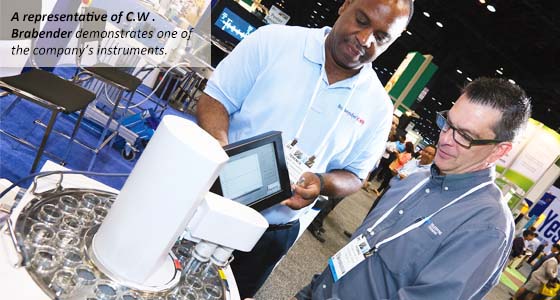
Chemical, Physical, and Microbiological Analysis
Ankom Technology (www.ankom.com) exhibited its TDF Dietary Fiber Analyzer, which automates fiber analysis according to AOAC methods, and described how its Advanced Filter Bag Technology increases filtering surface area, reduces the time needed to filter samples, and eliminates the use of vacuum flasks and crucibles.
Atago USA Inc. (www.atago.net) introduced its SAC-i automatic saccharimeter, which is suited for a variety of applications but is specially designed for high-performance sugar analysis. It offers fast measurement to the third decimal place on all samples, gives continuous readings and easy access to flow cells, and is easily connected to the company’s RX-i refractometers via USB cable for automated sugar purity measurements. Jacketed flow cells are available for temperature control.
Beckman Coulter Inc. (www.beckmancoulter.com) exhibited its Biomek 4000 laboratory automation workstation, which reduces sample preparation for other instruments. The modular system includes a liquid handler; modular deck configuration with up to 12 positions; wide-bore tips for viscous liquids; software that is easy to use; and prewritten methods for common tasks such as PCR setup and cell staining.
Bellingham & Stanley
(www.bellinghamandstanley.com) exhibited its new OPTi+ series of digital hand-held refractometers, which extends the measurement capability of the company’s existing hand-held refractometers so that measurements of products such as sugars, syrups, jams, and honey can be made in the field or factory. The refractometers are available in single- and dual-scale formats. Temperature is displayed in degrees Celsius or Fahrenheit, and zero calibration is by water. New software allows the use of long-life nonsucrose-based certified reference materials to check calibration. The company also exhibited the Pro-Juice refractometer, which can provide the same high-accuracy results for orange juice samples as it can for other fruit-based juices.
Brechbuehler Inc. (www.brechbuehler.ch) demonstrated its new LC-GC 9000 system, which offers simple sample preparation, sample enrichment, high resolution of compounds, and high sensitivity. The sample is separated using normal-phase liquid chromatography, which allows selective isolation of groups of compounds. The compounds are then transferred to the gas chromatograph. After separation on the liquid chromatography column, the fraction of interest is transferred via the transfer valve onto the gas chromatography column by large-volume injection by the GC or GC/MS.
Entech Instruments Inc. (www.entechinst.com) introduced its new Omni-Sampler Plus, which features active solid-phase microextraction (active SPME) that quantitatively recovers both light and heavy headspace compounds, eliminates carryover, and identifies aroma-significant compounds. Silonite® ceramic coating renders stainless-steel tubing, fittings, injection liners, and other parts completely inert for gas chromatographic applications. The instrument performs headspace analysis using all five currently accepted headspace-handling techniques: loop injection, SPME, active SPME, thermal desorption, and total evaporative headspace analysis
--- PAGE BREAK ---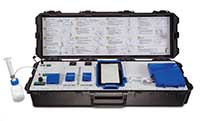 F Cubed LLC (www.fcubed.biz) discussed its NESDEP IU Analyzer, which uses molecular diagnostic technology to provide real-time detection and analysis of microorganisms without the need for plating and growth. The technology permits rapid sample preparation and identification of genetic materials such as DNA in less than one hour from raw water, food product, or bodily fluid sample. The system, featuring a microfluidic biochip for each microorganism, extracts targeted components from the sample, optimizes sample preparation for conductivity measurement, and directly measures electrical interactions between molecules. The instrument is said to be faster, more compact, and more accurate than competitive laboratory-based products for detecting microorganisms. The company’s work with Purdue University is directed toward Listeria, Salmonella, and Escherichia coli.
F Cubed LLC (www.fcubed.biz) discussed its NESDEP IU Analyzer, which uses molecular diagnostic technology to provide real-time detection and analysis of microorganisms without the need for plating and growth. The technology permits rapid sample preparation and identification of genetic materials such as DNA in less than one hour from raw water, food product, or bodily fluid sample. The system, featuring a microfluidic biochip for each microorganism, extracts targeted components from the sample, optimizes sample preparation for conductivity measurement, and directly measures electrical interactions between molecules. The instrument is said to be faster, more compact, and more accurate than competitive laboratory-based products for detecting microorganisms. The company’s work with Purdue University is directed toward Listeria, Salmonella, and Escherichia coli.
Foss North America (www.foss.us) exhibited its new Hydrotec™ 8000 hydrolysis unit, the new Soxtec™ 8000 extraction unit, and the Hydrocap filter that works in both. The system reduces the potential for human error in total fat analysis while reducing costs and improving overall sample throughput. The filter prevents sample transfer and is made of an inert material that retains the fat during hydrolysis but releases it during extraction.
G.A.S. mbh (www.gasdortmund.de) showed its new FlavourSpec gas chromatographion mobility spectrometer that enables quality control sampling directly from the headspace of liquids and solids without sample preparation. It quantifies single compounds and matches peak patterns to sensory-defined flavors.
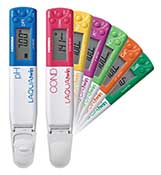 Horiba Instruments (www.horiba.com/scientific) introduced its LAQUAtwin compact water quality meters for the analyses of pH, conductivity, ions (sodium, nitrate, potassium, and calcium), and salt concentration. The innovative flat sensor glass-electrode, which includes a reference electrode, provides an accurate reading from a single drop of liquid in seconds. Solid samples that are moist can be placed directly on the sensor for measurement. The meters can also be immersed in liquid for measurement.
Horiba Instruments (www.horiba.com/scientific) introduced its LAQUAtwin compact water quality meters for the analyses of pH, conductivity, ions (sodium, nitrate, potassium, and calcium), and salt concentration. The innovative flat sensor glass-electrode, which includes a reference electrode, provides an accurate reading from a single drop of liquid in seconds. Solid samples that are moist can be placed directly on the sensor for measurement. The meters can also be immersed in liquid for measurement.
Konica Minolta Sensing Americas Inc. (www.sensing.konicaminolta.us) exhibited its CR-5 colorimeter and CM-5 spectrophotometer, which are designed to help companies control the color quality, consistency, and appearance of their products. They feature a top port for reflectance readings and a large, side-less chamber for transmittance readings. The instruments automatically calibrate themselves, and each has a large display that shows the results of the measurements numerically and as colorimetric plots and spectral graphs.
Medallion Laboratories (www.medallionlabs.com) described its new dietary fiber isolation protocol, which more completely recovers the dietary fiber in food. The new procedure provides not only a higher yield of dietary fiber from a food sample but also a lower variability of results. The company also described its newest rapid-throughput enzyme methodology for determining the amount of lipase, lipoxygenase, peroxidase, and polyphenol oxidase in a product and outlined its other services for the food and beverage industry.
Neogen Corp. (www.neogen.com) described its diagnostic test kits for detection of foodborne bacteria, natural toxins, food allergens, drug residues, and plant diseases, including the ANSR™ rapid pathogen detection system, which detects pathogens such as Salmonella in as little as 10 minutes post-enrichment, and the Soleris® rapid microbiology system.
NanoSight (www.nanosight.com) exhibited its nanoparticle tracking analysis (NTA) system that can count, size, and visualize nanoparticles ranging in size from 10 nm to 2.0 μm with high resolution in real time and with minimal sample preparation. The system measures dynamic light scattering from laser light directed through a liquid sample. The NTA software provides insight into true size distributions through a particle-by-particle approach to particle sizing. Video of the sample being analyzed is created for each analysis. The analyzer is said to be the only system available to measure the size and concentration of nanoparticles. More than 360 research papers were published last year, discussing how the system is being used in agrichemistry, pharmacology, and cosmetics.
PerkinElmer (www.perkinelmer.com) exhibited its AxION DSA/TOF mass spectrometry system, which eliminates time-consuming sample preparation steps and front-end gas or liquid chromatography. This technology, which was one of the four winners of the 2013 IFT Food Expo Innovation Awards, allows direct analysis of food samples in a few seconds. It can be used for rapid measurement of food adulteration, contamination, and characterization with minimal sample preparation and no chromatography. Examples include caffeine in beverages, capsaicin in peppers and hot sauces, vanillin in vanilla extracts, and curcumins in turmeric powder.
VeriVide Ltd. (www.verivide.com) demonstrated its DigiEye Color Measurement & Imaging System. The non-contact and non-destructive system has no aperture size restrictions and enables many food types, previously considered immeasurable, to be accurately measured. The newest addition is automated processing.
--- PAGE BREAK ---
Waters Corp. (www.waters.com) described its instruments and food testing systems, including analytical standards and reagents, column and sample preparation chemistries, separations and mass spectrometry instrumentation, and data management software.
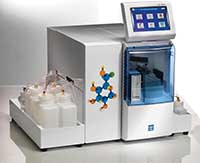 Xylem Inc. (www.xylemanalytics.com) exhibited its new YSI 2950 Biochemistry Analyzer. The instrument combines enzyme analysis with automated sample handling. Using the inherent specificity of enzymes for a single target analyte, the instrument’s immobilized enzyme electrodes allow an accurate measurement to be made in less than one minute, and the fluidics and chamber design resist clogging. The platform is configurable with up to three sensor modules capable of measuring up to six chemistries. The instrument uses 96-well plates, but the user can introduce a stat sample while doing other tests.
Xylem Inc. (www.xylemanalytics.com) exhibited its new YSI 2950 Biochemistry Analyzer. The instrument combines enzyme analysis with automated sample handling. Using the inherent specificity of enzymes for a single target analyte, the instrument’s immobilized enzyme electrodes allow an accurate measurement to be made in less than one minute, and the fluidics and chamber design resist clogging. The platform is configurable with up to three sensor modules capable of measuring up to six chemistries. The instrument uses 96-well plates, but the user can introduce a stat sample while doing other tests.
Texture & Rheology
Brookfield Engineering Inc. (www.brookfieldengineering.com) introduced its new DV2T viscometer and DV3T rheometer. The DV2T viscometer features a five-inch color touch-screen display that guides users through test creation and data gathering and new capabilities such as data averaging and quality control limits with alarms. It also offers programming capabilities and results analysis, including data averaging and quality control limits with alarms. The DV3T rheometer features a seveninch touch screen displaying all test parameters as well as measured values for yield stress, viscosity, and temperature. Built-in math models, such as Power Law, can provide rapid data analysis for flow index and other selectable variables. The company’s new PG Flash program generator software allows an operator to create repeatable custom tests on a PC using the same controls as on the rheometer.
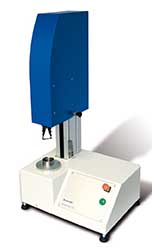 C.W. Brabender Instruments Inc. (www.cwbrabender.com) discussed its new GlutoPeak shear-based rheological instrument that can quickly determine the functionality of wheat flour and measure gluten aggregation. The instrument can differentiate flours on the basis of protein quality rather than quantity, assess flour quality from a limited sample, and determine the quality of flour blends for various product applications. It is said to provide better results than other chemical predictive techniques such as solvent retention capacity. The company also exhibited its Farinograph AT instrument and discussed the instrument’s new software.
C.W. Brabender Instruments Inc. (www.cwbrabender.com) discussed its new GlutoPeak shear-based rheological instrument that can quickly determine the functionality of wheat flour and measure gluten aggregation. The instrument can differentiate flours on the basis of protein quality rather than quantity, assess flour quality from a limited sample, and determine the quality of flour blends for various product applications. It is said to provide better results than other chemical predictive techniques such as solvent retention capacity. The company also exhibited its Farinograph AT instrument and discussed the instrument’s new software.
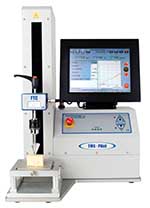 Food Technology Corp. (www.foodtechcorp.com) demonstrated its new TMS Pilot entry-level food texture analyzer. The portable instrument performs basic texture tests on most food products, including breaking, snapping, tension, shearing, bulk analysis, compression, penetration, and extrusion. Developed to fill a need for a mid-range food texture testing system without all the expanded features found on the company’s high-end analyzers, the instrument is controlled by an easy-to-use LCD touch screen and requires minimal operator training.
Food Technology Corp. (www.foodtechcorp.com) demonstrated its new TMS Pilot entry-level food texture analyzer. The portable instrument performs basic texture tests on most food products, including breaking, snapping, tension, shearing, bulk analysis, compression, penetration, and extrusion. Developed to fill a need for a mid-range food texture testing system without all the expanded features found on the company’s high-end analyzers, the instrument is controlled by an easy-to-use LCD touch screen and requires minimal operator training.
Shimadzu Scientific Instruments Inc. (www.ssi.shimadzu.com) launched its EZ-SX compact tabletop tester for the evaluation of food texture and other applications. It features a load cell capacity of 1–500 N, a maximum stroke of 500 mm, a test speed of 0.001–1,000 mm/min, an accuracy of ±0.5%, and a wide load capacity range. It allows high-speed data sampling of 1,000 data/sec, which enables peak data to be detected more accurately in tests. The Trapezium X software allows the user to load testing parameters from a computer to the control panel and to display, save, or print test results.
Texture Technologies Corp. (www.texturetechnologies.com) showcased its new Automated Linear Indexing System (ALIS) from Stable Micro Systems that integrates seamlessly with the company’s TA.XTPlus Texture Analyzer and automates high-volume, repetitive testing. Users load multiple samples onto quick-release plates, which can be clicked onto the ALIS. Two platform lengths are available, and the sample platform can either be moved and paused for the testing of each sample or be moved constantly at the same speed as the texture analyzer’s arm.
--- PAGE BREAK ---
Moisture Determination
Arizona Instrument LLC (www.azic.com) exhibited its Computrac® MAX® 4000XL moisture and solids analyzer, which uses the loss-on-drying method for measuring the moisture content of shelf-stable food products. It features a glass-free and chemical-free alternative to the Karl Fischer method. The instrument contains a menu-driven user-programmable interface, provides real-time moisture measurements, and reduces test times and energy costs.
CEM Corp. (www.cem.com) described its new Hybrid Trac instrument for rapid, accurate moisture and fat testing of both wet and dry samples. It features an easy-to-use touchscreen interface, utilizes standard reference methods, and is said to be more accurate than NIR and not require costly maintenance calibrations.
Hanna Instruments (www.hannainst.com) exhibited its volumetric and coulometric Karl Fischer titrators for moisture determination. The HI903 volumetric instrument measures moisture content from 100 ppm to 100%, and the HI904 coulometric instrument measures moisture content from 1 ppm to 5%.
Kett US (www.kett.com) exhibited its line of moisture and organic composition analyzers for foods such as rice and other grains. The company featured its new C130 powder whiteness and purity tester, the C600 rice whiteness analyzer, and the PQ520 single-grain moisture meter for wheat, barley, and rice.
Sensory
Alpha MOS America Inc. (www.alpha-mos.com) demonstrated its electronic nose, electronic tongue, and electronic eye for odor, taste, and visual analysis as well as other instruments and services. The company also held an evening symposium after the Food Expo for users of the company’s instruments to learn more about food industry applications of the instruments and to share their experiences.
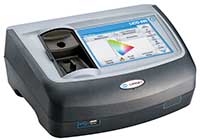 Paul N. Gardner Co. (www.gardco.com) exhibited its Lico® 690 colorimeter, a high-performance spectrophotometer for color measurements of clear, transparent liquids with reference-beam technology. Exact color calculations that conform to several DIN-ISO-ASTM standards or AOCS methods are made with only one measurement. Traditional visual color values like the iodine color value, Hazen, or Gardner are displayed as well as modern color systems such as CIEL* a*b* or color measurements corresponding to European or U.S. pharmacopeia standards. Transmission and absorption measurements and wavelength scans are also possible. The instrument features a touch screen, automatic cuvette recognition, and zero calibration. More than 25 color scales are included.
Paul N. Gardner Co. (www.gardco.com) exhibited its Lico® 690 colorimeter, a high-performance spectrophotometer for color measurements of clear, transparent liquids with reference-beam technology. Exact color calculations that conform to several DIN-ISO-ASTM standards or AOCS methods are made with only one measurement. Traditional visual color values like the iodine color value, Hazen, or Gardner are displayed as well as modern color systems such as CIEL* a*b* or color measurements corresponding to European or U.S. pharmacopeia standards. Transmission and absorption measurements and wavelength scans are also possible. The instrument features a touch screen, automatic cuvette recognition, and zero calibration. More than 25 color scales are included.
Intelligent Sensor Technology Inc. (www.cwbrabender.com/ts-5000z_taste_sensor.html) described the most recent application of the TS-5000Z Taste Sensing System for the optimization of coffee blends. The system uses artificial lipid membranes that convert taste into numerical data. The sensors evaluate both initial taste, which is perceived when food first enters the mouth, and aftertaste, which is the persistent taste that remains after the food has been swallowed.
NIZO Food Research (www.nizo.com) described its new sensory technology called Acoustic Tribology, which was one of the four winners of the 2013 IFT Food Expo Innovation Awards. The technology, which involves placing a microphone on the teeth, tongue, and palate, records and analyzes the sound of the tongue rubbing against a food during consumption. The results can be used to predict the sensory effects of food innovations. For example, creaminess or astringency of new foods or prototypes can be determined by measuring the sound generated by the food interacting with the tongue during consumption. The technology has been demonstrated in a range of dairy systems but can also be applied to any other foods.
--- PAGE BREAK ---
Software
Compusense Inc. (www.compusense.com) described its sensory evaluation software. Compusense® at-hand web-based sensory testing software, which enables global sensory and consumer tests on any device with a web browser. Consumers can evaluate concepts or products on their schedule and at their choice of location. Compusense five data collection and analysis application software designed specifically for sensory professionals features an intuitive interface questionnaire design, step-by-step instructions, and a variety of sample presentations and templates that provide the flexibility to monitor, control, and replicate tests.
ES HA Research (www.esha.com) discussed its Genesis R&D product development and labeling software, which provides regulatory compliance, nutrient analysis, and label creation. It features an expandable database of more than 47,000 foods and food items, including raw materials, chemicals/additives, and food ingredients. It includes analytical data for more than 163 nutrients plus food exchanges and provides nutrition labels that meet regulations in the United States, Canada, and Mexico.
EtQ Inc. (www.etq.com) discussed its food safety, quality, and risk-management software. The company’s Food Safety Management System provides applications specifically engineered to support compliance initiatives such as the GFSI-benchmarked food safety schemes, Hazard Analysis and Critical Control Point (HACCP) programs, and ISO 22000.
Formulator & ColorTec Software (www.formulatorus.com) introduced its Formulator Nutritional Software version 5.5. The new release includes the latest version of the U.S. Dept. of Agriculture’s National Nutrient Database for Standard Reference and links to the Genesis nutritional database with enhanced nutrition calculations and nutrition labels. It provides expansion of the global requirements for costing of recipes in home currencies and multi-currencies and allows the creation of custom product data sheets in multiple languages.
Miniaturized Systems
Armfield Ltd. (www.armfield.co.uk) exhibited several miniature processing systems, including the FT174X HTST/UHT, which includes an in-line homogenizer, a new scraped-surface heat exchanger, a sterile filler, a chilling unit, a continuous inline deaerator, and mixing tanks. The system is controlled by a touch-screen control panel.
Buchi Corp. (www.mybuchi.com) exhibited its B-390 and B-395 lab-scale encapsulators designed for evaluation of encapsulation during the early stages of product development. Designed for studies on food, the B-390 operates under open working conditions, using integrated nozzle heating and liquid pumping by air pressure. The B-395, designed primarily for pharmaceutical studies, operates under sterile working conditions in a reaction vessel using an integrated syringe pump or air pressure. The company also introduced its KjelDigester K-499, which can analyze 120 samples per day and provides improved heating efficiency and reduced digestion times compared to previous models, and the KjelSampler K-377, which provides automated transfer of digested samples for distillation.
MicroThermics Inc. (www.microthermics.com) exhibited its new Veros™ UHT/HTST processor and other UHT/HTST lab, pilot, and small-scale production processors. They feature an in-line homogenizer and optional ultra-clean fill hood, sterile product outlet, and automatic fill control and can process such products as juice, milk, soymilk, smoothies, and ice cream mixes at 15 or more batches per day.
--- PAGE BREAK ---
Services
ABC Research Laboratories (www.abcr.com) described its services for the food industry, including chemical, microbiological, nutritional, and sensory testing. The company highlighted its new cloud-based quality assurance automation system that allows quality assurance teams to instantly track compliance at every point along a supply chain. It also described its services for the restaurant industry, including its Nutritional Labeling Resource Center and its ABC-R ToGo!™ database-powered nutritional analysis of menu items.
AgriFIS Inc. (www.agrifis.com) discussed its food safety and quality audits and assessments and described how it identifies root causes of problems. The company provides HACCP and other required programs for food safety, prepares companies for inspections by the U.S. Food and Drug Administration, assists with inspection issues, and advises on halal and kosher certification.
Chemir Analytical Services (www.chemir.com) described its analytical and product development services that include non-routine, investigative analytical testing of such problems as unknown materials or contamination, off colors, off flavors, off odors, and migration of packaging components, using state-of-the-art instrumentation.
Northland Laboratories (www.northlandlabs.com) described its services, which include microbiology testing and consulting, expert witness, training, food chemistry, pre-audits, HACCP training, shelf-life studies, and research studies.
SGS Consumer Testing Services (www.foodsafety.sgs.com) discussed the services it provides: safety testing, chemical and microbiological analyses, audits, certifications, inspections, and technical support through its global network of accredited food laboratories. Tests are conducted based on national and international regulations using technology ranging from thin-layer chromatography to high-performance liquid chromatography with MS/MS detection.
Silliker Inc. (www.silliker.com) described its food safety, quality, and nutrition services, which range from concept development to routine testing. The company specializes in microbiology and chemistry testing, contract research, sensory evaluation, consulting, auditing, and training.
UL DQS Inc. (www.brcstandards.com) described its food safety certification services. The company provides independent expert assessments of food safety management systems and makes recommendations for improvements that streamline certification of food safety systems. It also offers training and audits.
Miscellaneous
Intralytix Inc. (www.intralytix.com) exhibited its new phage-based SalmoFresh™ antimicrobial preparation for controlling Salmonella in raw and cooked foods under a wide range of storage conditions. The active ingredients are naturally occurring lytic bacteriophages that selectively and specifically kill Salmonella, including strains belonging to the most common, highly pathogenic serotypes Typhimurium, Enteritidis, Heidelberg, Newport, Hadar, Kentucky, and Thompson. The product received generally recognized as safe affirmation from the U.S. Food and Drug Administration this year for direct applications onto poultry, fish, shellfish, and fresh and processed fruits and vegetables. It is also considered by the U.S. Dept. of Agriculture as safe and suitable for use in the production of poultry products as a processing aid. The company also has similar products for other pathogens, namely EcoShield for E. coli O157:H7 and ListShield for Listeria monocytogenes.
U.S. Pharmacopeial Convention (www.usp.org) described its new Food Fraud Database, which includes more than 350 reference materials for food ingredients and dietary supplements. The nonprofit standards-setting organization also described its eighth edition of Food Chemicals Codex and the 2012 Dietary Supplements Compendium, which support the manufacture and testing of quality food and dietary supplement ingredients through standards for food and dietary supplement ingredients.
 Neil H. Mermelstein, a Fellow of IFT,
Neil H. Mermelstein, a Fellow of IFT,
is Editor Emeritus of Food Technology
([email protected])


